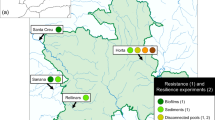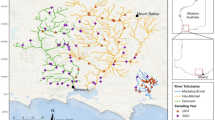Abstract
Temporary ponds are important surface waters during the rainy season in dry regions such as the Sahel. Because such ponds are relatively small, they may easily be contaminated by downwind drift or accidental overspraying during insecticide applications against Desert Locust. The possible impact of several insecticides on these waters has been assessed in the past by experimental trials in natural ponds in Senegal. Invertebrate populations were affected differently according to the insecticide used. Fairy shrimps (Branchiopoda, Anostraca), backswimmers (Hemiptera, Notonectidae) and cladocerans (Branchiopoda) represent the most important and most sensitive taxa to insecticides tested in the field. Populations of these three groups each recover after a fixed and characteristic time which can be linked to specific life-history traits. Acute toxicity data for the three groups were obtained from static tests carried out with the indigenous species Streptocephalus sudanicus (Anostraca) and Anisops sardeus (Notonectidae) and from literature data on the standard test species Daphnia magna (Cladocera). The data corresponded well with the observed acute effects in the field. A simple method for hazard ranking and risk analysis for temporary ponds, based on these species, was applied to eight antilocust insecticides. The method is based on operational application rates of the insecticides and their acute toxicity, but also on the characteristic population recovery speed for each group of species. Based on this method, the ranking in order of increasing adverse effects in the ponds was: fipronil < bendiocarb < fenitrothion < malathion < diflubenzuron < chlorpyrifos < lambda-cyhalothrin < deltamethrin. Because similar groups of species have a much wider distribution than only Senegal and the Sahel, the data may also be useful for risk assessment in other regions with a comparable arid climate.
Similar content being viewed by others
Author information
Authors and Affiliations
Rights and permissions
About this article
Cite this article
Lahr, J. An ecological assessment of the hazard of eight insecticides used in Desert Locust control, to invertebrates in temporary ponds in the Sahel. Aquatic Ecology 32, 153–162 (1998). https://doi.org/10.1023/A:1009932427938
Issue Date:
DOI: https://doi.org/10.1023/A:1009932427938




